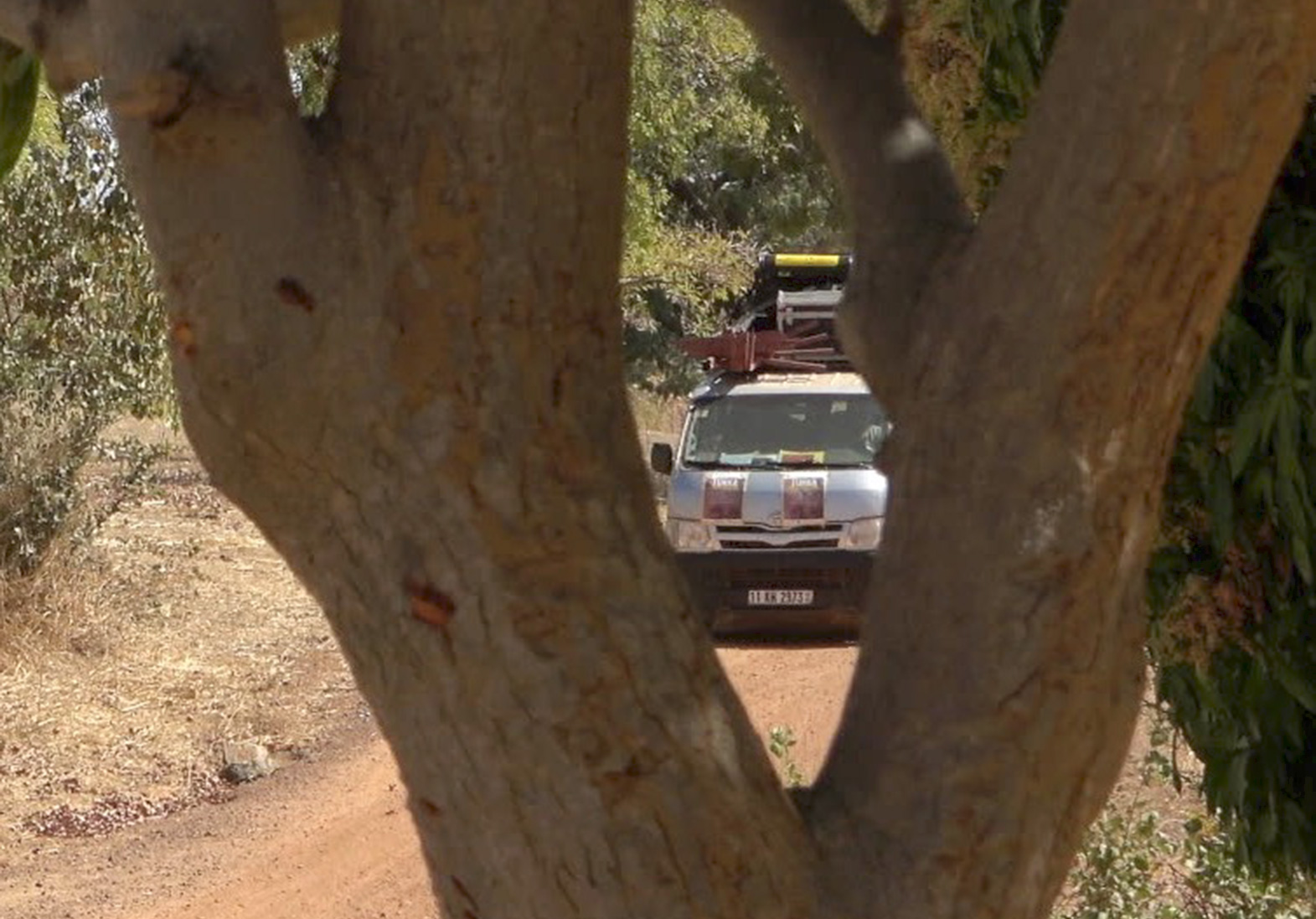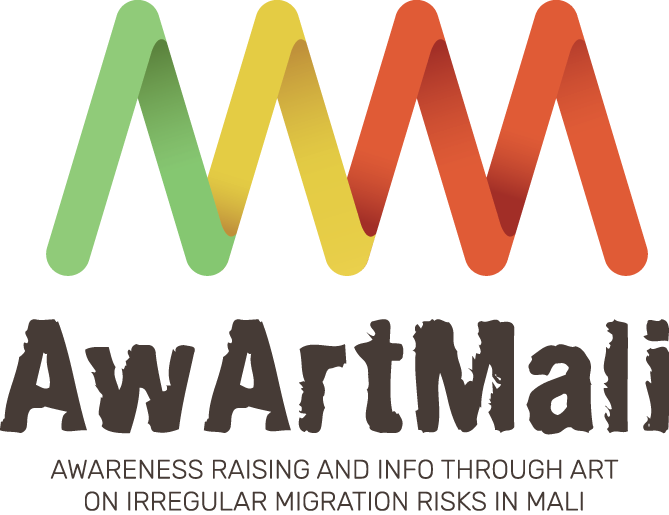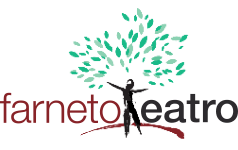A theatrical caravan is planned to make the population aware of the potential risks and an App to inform them of the opportunities
TAMADENW – A caravan towards Mali

The departure of the Tunka Caravan, the central activity of AwArtMali Project, catapulted all the participants into a new experience, full of suggestion and human contact, every day the same but every day deeply different and surprising. It was a very intense time, it allowed us to get to better know the beauty of Mali and the drama of migration. This because when we talk about migration, we talk not so much about cities, as about brousse, about an agricultural world in crisis: we have no certainty that it is like that, but we know that it is what everyone has told us.
Cercle de Kati is a province of about 1,200,000 inhabitants which is part of the Koulikoro region. Inside it is contained – as an independent city-state – the capital Bamako (more than 3.000.000). Kati is about twenty km far from Bamako and it is believed to have 130,000 inhabitants. The four villages chosen by the project are all located within 30/40 Km from Kati and are believed to have around 50,000. We can say nothing but very
generic figures unfortunately. But these numbers already tell us about the relationship between the city and the countryside (the brousse). The villages of these four rural municipalities, as they get closer to the city, become more populous, less cared for, more and more resemble places of transit.
It is evident that instead, in the most remote ones, you can feel the permanence of social structures which, as you get closer to the city, seem to be in crisis. The welcome most linked to the ancient sense of hospitality is that we have received in the most distant villages, where the relationship of trust and openness towards the message of the caravan has been greater. Elders who listen to you in the same positions as their fathers centuries ago, rituals acted with feeling, rules.
The unwary western traveler will be amazed not to catch here those attitudes of poverty and social degradation typical of the city banlieu. Here there are fields, vegetable gardens, large trees, the image of the landscape is rather bucolic. They are dignified and well-kept villages. Yet it is from here that tamadenw leave for their aventure. We are now in the harvest period, soon the retail price of the products will fall, then for the next four months it will not rain again, the temperatures will reach 45 °, the market prices will increase and the young people will no longer have work until the next rains. They will do what the Malian peoples of the warmer regions have been doing since immemorial time: migration.
The tour of the villages
The caravan leaves Kati every day around 1pm and reaches a new village. The reception in the most distant villages is always sensational, frequently with masks and welcoming dances by the women of the village. The show is expected as a very important event. It almost never happened to arrive in a village and not find at least a hundred children waiting. Many times they were already sat down, deciding the stage space by themselves. The following is a lot of fun, when hundreds of people have to be moved…
It was decided to concentrate the shows by zones. We will start with the most distant municipalities and end with the closest municipalities. We will therefore start with all the villages in the Yelekebougou area. Doing so will help the word-of-mouth and the promotion of the project through spectators-witnesses: the whole area will feel crossed by the show and therefore the nearby shows will mutually reinforce each other. We will begin with an opening ceremony in Kati and will end with a closing ceremony in Yelekebougou. Even in this way, the show will assert its movement from the city to the countryside.
The timetable was chosen togheter with the representatives of the community: start of the show has to be between 3 and 5 pm. Here the work in the fields starts early and the sunset is around 6.30 pm. Even if we wanted, there is no possibility of being in time as European do: the start time is very vague, it is the end time that is precise and corresponds with sunset, when all children and all women have to go home. This schedule, which could be called “at some hour in the afternoon, as long as it’s finished for sunset”, allowed a wide participation: between 300 and 400 people for each village, around 800 on the final date.
The very agile stage system is mounted on the ground after sweeping the earth, (an event that western people would hardly take into consideration). The public is seated on a hundred chairs rented on the spot; chair rental is a rather developed activity, at the fixed price for the project of 100 francs per chair, the cost of a plate of ris gras (seasoned rice). Mats are laid out in front, provided by the company, for children: incredible how many of them can fit on a mat. Then there are sdded benches, sometimes school desks, brought by the public itself. And finally, all the other spectators remain standing, in a semicircle behind the others.
Nobody eats, nobody drinks. Every energy is for the story told by the theater. The most beautiful images of our video documentary will be the close-ups of the audience during villages shows.
The audience of the villages.
The public in the villages is incredibly attentive and silent. If he talks and laughs it’s for the show. And it laughs a lot, laughs out loud, which can be disconcerting at first.
It often happens that very dramatic situations are acted: the audience laughs irresistibly. But they do not do it because of insensitivity, they knows very well that there is horror and violence, death and fear in life. They do not laugh at the topic, but at the medium: they are amazed that life can be talked about, by distancing it, through the same means as children use by playing. They laugh at the theater, and doing so, they carefully analyze the story.
Relationships within communities, which are based on rules of behavior and relationships between generations and sexes consolidated and rooted in traditions, are also captured by observing the public’s disposition.
The participants are almost always arranged by social and age groups. Women, separated from men, in large groups of friends (many with the last child on their back). In the villages there are often women’s associations, and in general the ladies seem very active (they invent activities, the literate organize courses, they are usually the holders of micro-credit).
The elderly men, sometimes very aged (among them, almost always, the head of the village), have given their approval and look at it in a central position; adult men are not a very large group, but are particularly concentrated, often standing. Among them the returning migrants, some of whom were interviewed in the previous months. The young people arrange themselves at the edges, first, curious but ready to leave on a motorbike; then, generally very careful.
Children of all ages ahead: the great attention of the children was surprising. Tunka is not aimed at children, but the physical actions that dot the show, the exceptional nature of the event, involved them very much, right from the stage assembly. Then there is the irresistible curiosity for the few “tubabu” arriving in the village (whites are a rarity here). Regarding this, in Mali there is a great attention to the greetings and everything related to the welcome rituals, so the little ones do not want to be outdone: before and after the show they surround the guests, they want to greet them, give a hand, beat the five, all in a very festive atmosphere.
Viewers of the theatre generally know what the show is about; there is no theater without a social content in Mali, (assuming that the spectators have ever had experience of theater, at school or in other shows). However, interest, curiosity and the charme for the actors’ game clearly prevail in their expectation, rather than to deal about migration. We can say: they are there, because there is a theater and they would be happy with it, whatever it was. T
his leaflet is distributed to the spectators, containing the purposes of the show and the project in French and in Bambara.
You have to choose well the time to make this distribution, because as soon as the distribution starts, there is a pandemonium. In a village where they have very few notebooks and school books, a piece of paper with an image like this one, will be jealously preserved and will enter every home. After the show, it will be impossible to find scattered and abandoned leaflets on the ground, as it would happen to this type of promotion in Europe.
Returning migrants
Those who have a more specific interest are returning migrants and especially those who, through interviews, have collaborated in the making of the show. Some of them, obviously without any personal quotation, will face their own story, or the story they told. We have already a personal relationship with them; during the tour, more in-depth knowledge will be born. And we will aim to return to interview them, after they have seen the show: it will be an important testimony of its impact. Being able to compare (and edit, in the final video documentary) their point of view, before and after the show, will be interesting.
But returning migrants will do even more: they constitute the very first line of the project and their interventions in the debate after the end of the show, will obviously have great impact. Nobody can be more convincing, than those who know the subject matter deeply and who, very often touched by the objectivity of the theatrical story, take the floor and the courage to tell their adventure to the whole village, recommending everyone not to leave in the conditions of irregularity in which he left.
Organization and role of Le Tonus
The role of the animators and all the logistical and organizational support of the local partner Le Tonus, is also very important in the tour. The show in the village is only the final moment of a long preparation. Le Tonus has made available spaces, means of locomotion, relations with the territory and, above all, a credibility evidently gained through years of work, such that the arrival in any village is greatly facilitated.
The three Le Tonus mediators are divided the territory, each one taking care of six villages. Their work began with long talks with Farneto Teatro to share the project. Then the proposal and explanation of the project continued with the identification and contact of the individual village communities; then there was the identification of those people who could be available for interviews within the villages communities. Then there was the mediation work in all the missions of Farneto: accompaniment, translation from Bambara during the interviews (French in the villages of Mali is rarely spoken). Then there was all the on-site work for the choice of places for the shows. Finally the accompaniment of the Caravan and, above all, the most delicate activity: the management of the debates, which constitute the second half of the show and the decisive moment of our project.
Such complex work cannot be carried out well on such a sensitive and humanly delicate topic in the villages, if one is not equipped with a vision of the problem and is not motivated to search for a way to solve it.
Then there are other people who need to be thanked for organizing the project. These are not employees of Le Tonus: they are all those people who in each village believed in the project and became its local organizers.
The following is a summary scheme of the numbers of the caravan in the villages. The indicators that seem most interesting to us, are the number of spectators, the number of interviewed people per village and the number of those present among among those interviewed, the duration of the debates and the number of interventions. Finally, the enumeration of some special participations among the public.
What is AwArtMali
AwArtMali aims to contribute to the change of perceptions and behaviour of Malian people looking to irregular migration towards the EU as the only solution to their socio-economic problems.
The action is intended to reach and involve Malian people in order to make them aware and inform them on the risks of irregular migration, on legal alternatives and on economic opportunities available in their country with a multistakeholder approach consisting in awareness campaign and information activities.













